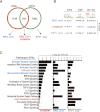ETV1 directs androgen metabolism and confers aggressive prostate cancer in targeted mice and patients
- PMID: 23512661
- PMCID: PMC3613614
- DOI: 10.1101/gad.211011.112
ETV1 directs androgen metabolism and confers aggressive prostate cancer in targeted mice and patients
Abstract
Distinguishing aggressive from indolent disease and developing effective therapy for advanced disease are the major challenges in prostate cancer research. Chromosomal rearrangements involving ETS transcription factors, such as ERG and ETV1, occur frequently in prostate cancer. How they contribute to tumorigenesis and whether they play similar or distinct in vivo roles remain elusive. Here we show that in mice with ERG or ETV1 targeted to the endogenous Tmprss2 locus, either factor cooperated with loss of a single copy of Pten, leading to localized cancer, but only ETV1 appeared to support development of invasive adenocarcinoma under the background of full Pten loss. Mechanistic studies demonstrated that ERG and ETV1 control a common transcriptional network but largely in an opposing fashion. In particular, while ERG negatively regulates the androgen receptor (AR) transcriptional program, ETV1 cooperates with AR signaling by favoring activation of the AR transcriptional program. Furthermore, we found that ETV1 expression, but not that of ERG, promotes autonomous testosterone production. Last, we confirmed the association of an ETV1 expression signature with aggressive disease and poorer outcome in patient data. The distinct biology of ETV1-associated prostate cancer suggests that this disease class may require new therapies directed to underlying programs controlled by ETV1.
Figures







Comment in
-
Commentary on "ETV1 directs androgen metabolism and confers aggressive prostate cancer in targeted mice and patients." Baena E, Shao Z, Linn DE, Glass K, Hamblen MJ, Fujiwara Y, Kim J, Nguyen M, Zhang X, Godinho FJ, Bronson RT, Mucci LA, Loda M, Yuan GC, Orkin SH, Li Z, Division of Hematology and Oncology, Boston Children's Hospital, Boston, MA, USA.: Genes Dev 2013;27(6):683-98.Urol Oncol. 2014 Feb;32(2):213. doi: 10.1016/j.urolonc.2013.08.016. Urol Oncol. 2014. PMID: 24445296
References
-
- Bauer DE, Hatzivassiliou G, Zhao F, Andreadis C, Thompson CB 2005. ATP citrate lyase is an important component of cell growth and transformation. Oncogene 24: 6314–6322 - PubMed
-
- Bismar TA, Dolph M, Teng L-H, Liu S, Donnelly B 2012. ERG protein expression reflects hormonal treatment response and is associated with Gleason score and prostate cancer specific mortality. Eur J Cancer 48: 538–546 - PubMed
-
- Bolstad BM, Irizarry RA, Astrand M, Speed TP 2003. A comparison of normalization methods for high density oligonucleotide array data based on variance and bias. Bioinformatics 19: 185–193 - PubMed
Publication types
MeSH terms
Substances
Associated data
- Actions
Grants and funding
LinkOut - more resources
Full Text Sources
Other Literature Sources
Medical
Molecular Biology Databases
Research Materials
